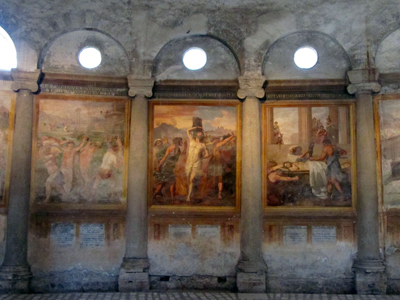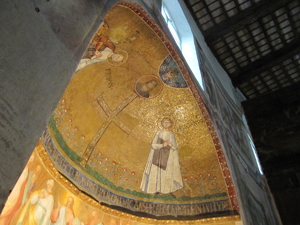SUN AN’ SOUL - DREAM AN’ ROME
SANTO STEFANO ROTONDO
 |
| Santo Stefano Rotondo - click to enlarge |
The church of Santo Stefano Rotondo was built by Pope Simplicio, 468-483, on pre-existing Roman buildings; excavations conducted since 1970 have uncovered a mithreum (environments dedicated to the cult of Mithras), probably belonging to the “Castra Peregrina”, that housed the soldiers of the Roman provinces detached in Rome.
Simplicio built a church with a complex plan, as it was made up of three concentric circles, the innermost of which was covered by a central dome supported by 22 ancient columns, as ancient are the capitals and the architrave . Followed an annular nave delimited by 34 columns, intersected by a cross, ending with a colonnade, which was also annular.
To hold up the dome
around 1130 Pope Innocent II built the three big central arches supported by two gigantic ancient granite columns and always for static reasons the 34 columns of the annular nave were incorporated
in the current perimeter wall and they are still visible.
 |
| Columns incorporated in the perimeter wall - click to enlarge |
While the care of the Popes, on their return from the exile in Avignon (1377), was focused on St. Peter's in the Vatican, the churches of Celio hill fell into a state of disrepair, so very little remains of the rich decoration of Santo Stefano Rotondo
and simultaneously were suppressed three of the four arms of the Cross, the only survived now serves as a vestibule to enter the church. The annular outer porch was abandoned.
In 1580 Pope Gregory XIII Boncompagni entrusted the church to the Jesuits, who commissioned Niccolò Circignani, one of the three painters known as Pomarancio, to be born in Poamrance, to fresco
the ambulatory with 34 scenes of martyrdom,
to prepare novices destined for the missions to the ultimate sacrifice.
Of the earliest period of the church has remained the Chair, which tradition attributes to Gregory the Great and the beautiful chapel of Saints Primo and Feliciano with its Byzantine mosaics of the seventh century, the only ones of this age survived in Rome.
Santo Stefano Rotondo is the national church of Hungary.
 |
 |
| Chapel of Saints Primo and Feliciano - click to enlarge |
back |

